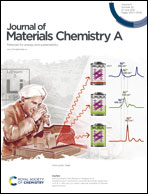Hierarchical confinement of PtZn alloy nanoparticles and single-dispersed Zn atoms on COF@MOF-derived carbon towards efficient oxygen reduction reaction†
Abstract
Covalent organic frameworks (COFs) and metal–organic frameworks (MOFs) are attracting significant attention for their enormous range of applications because of their designable and controllable skeletons and porosities. Integrated MOF/COF materials are well developed in gas absorption, photocatalysis, and chemical sensors. Here, an ultrastable COF@MOF-derived catalyst has been first synthesized, in which hollow carbon acts as a support to confine Pt–Zn intermetallic nanoparticles and isolated Zn atoms. The COF on the surface of the MOF facilitates the construction of a hollow structure, and the MOF prevents the collapse and aggregation of the COF coating in the pyrolysis process. The resulting catalyst has Pt–Zn intermetallic nanoparticles with an average size of 3 nm supported on the hollow carbons with atomic Zn distributions. Based on the combination of the active Zn atoms and Pt–Zn clusters/nanoparticles, the catalyst displays high catalytic activity towards ORR with half-wave potentials of 0.85 and 0.85 V, which were more positive than those of Pt/C in alkaline and acidic conditions, respectively. More importantly, the catalyst exhibits excellent long-term stability over 20 hours. This work provides new guidance for designing core–shell MOF/COF materials for electrocatalysts, which is key to systems for energy conversion and storage.



 Please wait while we load your content...
Please wait while we load your content...